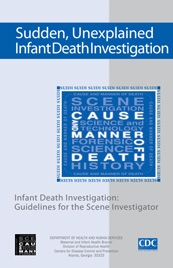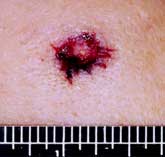|
View in browser: https://www.crime-scene-investigator.net/newsletter/1119.html
|
||
|
NOVEMBER 2019 | ||
| ||
|
This Month's Featured Resource on the Crime Scene Investigator Network Website
|
||
 This publication, provided by the Centers for Disease Control and Prevention, provides useful guidelines for the investigation of sudden, unexplained infant deaths. Contents include investigative tools and equipment, arriving at the scene, documenting and evaluating the scene, documenting and evaluating the body, establishing infant profile information, and completing the scene investigation. |
||
|
New CSI and Forensic Job Announcements
|
||
|
The most comprehensive listing of Crime Scene Investigation and Forensic To be notified of job openings as they are posted, follow us on Twitter: Job Posting Alerts |
||
|
Forensic Analyst
Washington County Sheriff's Office, Hillsboro, Oregon, USA Final Filing Date: November 24, 2019 Incumbents in this position will function as both certified latent print examiners and certified crime scene analysts. Successful candidates will be expected to perform advanced journey-level work and use a significant level of independence, judgment, and expertise in the forensic analysis of physical and trace evidence that has been collected from crime scenes. Forensic Analysts also perform higher-level analysis of crime scene evidence, including cases involving violent crimes. <View complete job listing> |
||
|
Crime Scene/Lead Evidence Technician
Bremerton Police Department, Bremerton, Washington, USA Final Filing Date: November 27, 2019 The position requires working at crime scenes, conducting forensic examinations and processing evidence utilizing forensic techniques in the lab, preparing field and lab reports, and testifying to findings. In addition, this is the lead position in the Bremerton Police Department property room. <View complete job listing> |
||
|
Forensic Technician
Portsmouth Police Department, Portsmouth, Virginia, USA Final Filing Date: November 29, 2019 Identifies, collects, preserves, documents, and processes physical evidence independently from complex crime scenes, and victims and suspects; collects latent fingerprints; photographs and sketches crime scenes; maintains chain of evidence; processes and maintains digital images; transports evidence to and from state crime lab; and coordinates with detectives and all appropriate laboratories. Documents crime scenes using sketching and measurements, photography and videotaping; <View complete job listing> |
||
|
Firearms Examiner
Colorado Springs Police Department, Colorado Springs, Colorado, USA Final Filing Date: November 19, 2019 As a Firearms Examiner for CSPD's (Colorado Springs Police Department) Metro Crime Lab, you will perform firearm and toolmark examinations, prepare technical reports that support analytical findings, and present them in a court of law through expert witness testimony. <View complete job listing> |
||
|
Criminalist I, II, or III (DNA Casework)
Missouri State Highway Patrol Crime Laboratory, Jefferson City, Missouri, USA Final Filing Date: November 21, 2019 This is an entry-level position where the employee performs technical work in the scientific analysis of body fluids. An employee in this position participates in a formal and on-the-job training program. Work is performed under immediate supervision. <View complete job listing> |
||
 |
||
|
Laboratory Technician I, Forensic Science
Maryland State Police, Pikesville, Maryland, USA Final Filing Date: December 9, 2019 The main purpose of this position is to process crime evidence and test fires for entry into the Bureau of Alcohol, Tobacco, Firearms and Explosives (ATF) National Integrated Ballistic Information Network (NBIN) database. <View complete job listing> |
||
|
Latent Fingerprint Examiner
Miami-Dade Police Department, Doral, Florida, USA Final Filing Date: December 16, 2019 Develops, evaluates, compares and identifies latent prints; prepares court exhibits and renders testimony in courts of law. Evaluates, enters, compares and identifies prints in the AFIS. Performs latent processes on items of physical evidence utilizing various chemical formulas. Evaluates latent evidence utilizing alternate light sources. Provides latent identification services for other municipalities, counties, state, and federal agencies. Reviews and verifies latent print identification. <View complete job listing> |
||
|
Medicolegal Death Investigator
Utah Office of the Medical Examiner, Taylorsville, Utah, USA Final Filing Date: December 1, 2019 Perform scene investigations which include researching and gathering information, interviewing witnesses, and writing investigative findings as documentation for the Utah Medical Examiner Database; and the determination of jurisdiction of deaths reported to the OME. Assist medical examiners/forensic pathologists with complete documentation of evidence collected and recorded chain of custody, reports, and records gathering and review, and other requests as needed. <View complete job listing> |
||
|
Search for more job listings in Crime Scene Investigations and Forensics To be notified of job openings as they are posted, follow us on Twitter: Job Posting Alerts |
||
|
Other Resources on the Crime Scene Investigator Network Website
|
||
|
Not Subscribed to this Newsletter?
|
||
|
If you are not subscribed to this newsletter, you may subscribe with this link: SUBSCRIBE via email |
||
|
To Unsubscribe
|
||
|
To unsubscribe from future e-mail alerts, please click here: UNSUBSCRIBE Copyright ©2019 Crime Scene Resources, Inc. Crime Scene Investigator Network |



